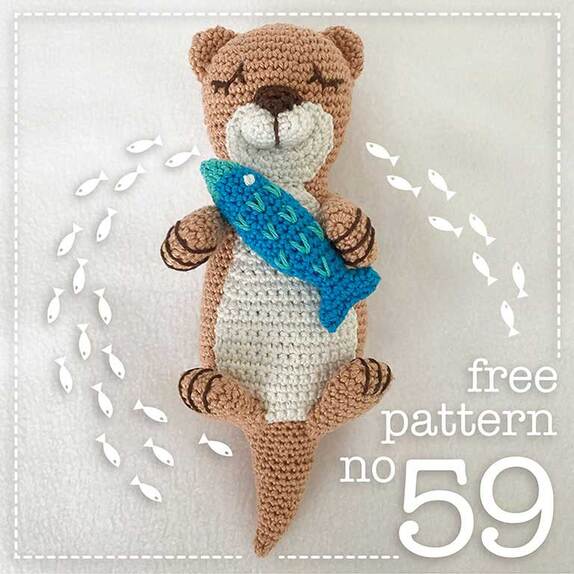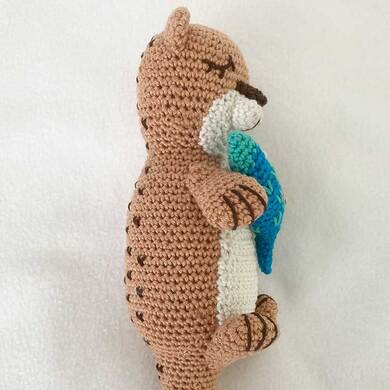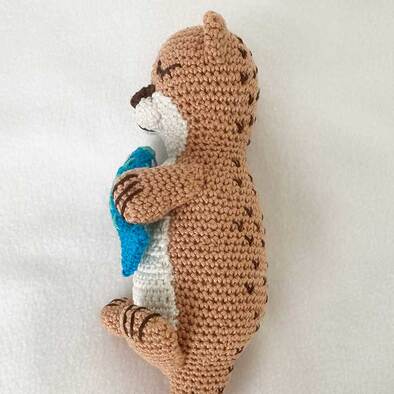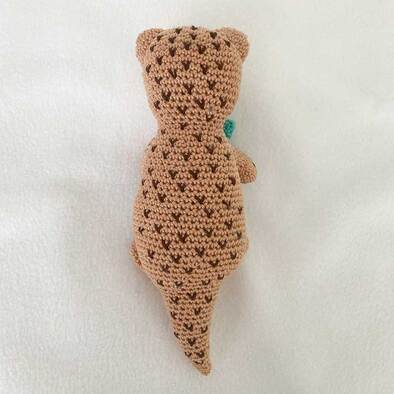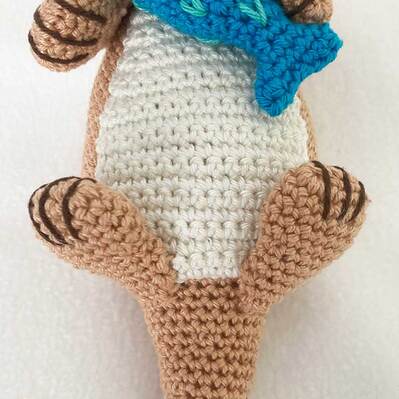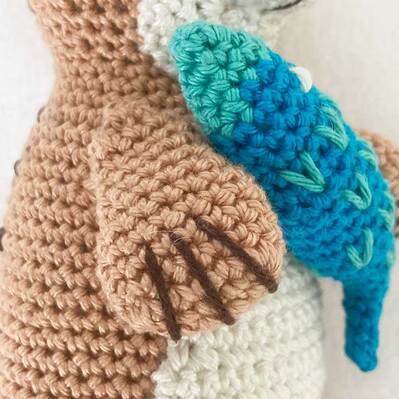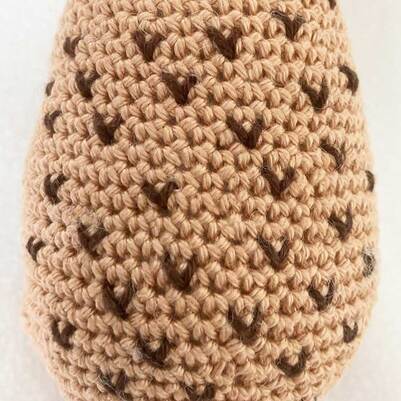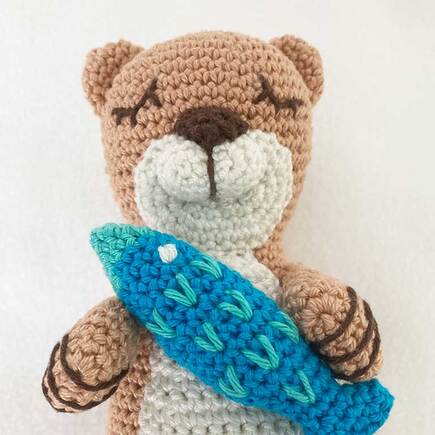Free Amigurumi Crochet Otter Pattern
Yarn
Scheepjes Catona. 100% Cotton. 125m per 50g
MC: 50g approx of Camel (502) for Head and Body, Paws and Ears.
CC1: 15 g approx of Old Lace (130) for Face and Belly Patches, Muzzle and Fish Eye.
CC2: 5g approx of Black Coffee (162) for Nose and Embroidered details.
CC3: 5g approx of Tropic (253) for Fish.
CC4: 10g approx of Vivid Blue (146) for Fish.
A cotton yarn works well for Ami as it gives good stitch definition and creates a firm structure so body parts hold their shape well. Scheepjes Catona is a relatively thick 4 ply (US: Sport) - you can substitute a DK Cotton (US: DK/Light Worsted) with a similar amount of metres per 50g.
Scheepjes Catona. 100% Cotton. 125m per 50g
MC: 50g approx of Camel (502) for Head and Body, Paws and Ears.
CC1: 15 g approx of Old Lace (130) for Face and Belly Patches, Muzzle and Fish Eye.
CC2: 5g approx of Black Coffee (162) for Nose and Embroidered details.
CC3: 5g approx of Tropic (253) for Fish.
CC4: 10g approx of Vivid Blue (146) for Fish.
A cotton yarn works well for Ami as it gives good stitch definition and creates a firm structure so body parts hold their shape well. Scheepjes Catona is a relatively thick 4 ply (US: Sport) - you can substitute a DK Cotton (US: DK/Light Worsted) with a similar amount of metres per 50g.
Hook
3mm
3mm
Other Supplies
Yarn needle, toy stuffing, stitch marker/waste yarn, pins and scissors.
Yarn needle, toy stuffing, stitch marker/waste yarn, pins and scissors.
Tension
24 sts x 27 rows = 10cm measured over dc using 3mm hook.
Tension is not critical for this project but stitches should be tight enough to avoid stuffing showing through.
24 sts x 27 rows = 10cm measured over dc using 3mm hook.
Tension is not critical for this project but stitches should be tight enough to avoid stuffing showing through.
Size
23 cm (9 in) approx from top to toe.
23 cm (9 in) approx from top to toe.
Pattern Notes
Unless otherwise specified this pattern is worked in the amigurumi style, in a continuous spiral without slip stitching or turning chains.
Where colour changes are indicated, they take place on the last yrh of the last dc of the previous rnd.
Use a stitch marker or waste yarn to keep track of the first stitch of each round.
If you don't want to make a Magic Ring you can start each piece by making a chain of 2 and then work the first round into the second chain from the hook.
If you'd like to start with a Magic Ring but don’t know how, you can find a Photo Tutorial HERE.
The Otter is made of multiple separate pieces sewn together. Unless otherwise stated, finish each piece by pulling the yarn through the last loop and leave a long tail for sewing. Any loose tails at the end can be easily woven in.
Unless otherwise specified this pattern is worked in the amigurumi style, in a continuous spiral without slip stitching or turning chains.
Where colour changes are indicated, they take place on the last yrh of the last dc of the previous rnd.
Use a stitch marker or waste yarn to keep track of the first stitch of each round.
If you don't want to make a Magic Ring you can start each piece by making a chain of 2 and then work the first round into the second chain from the hook.
If you'd like to start with a Magic Ring but don’t know how, you can find a Photo Tutorial HERE.
The Otter is made of multiple separate pieces sewn together. Unless otherwise stated, finish each piece by pulling the yarn through the last loop and leave a long tail for sewing. Any loose tails at the end can be easily woven in.
UK Crochet Terms - Abbreviations
This pattern is written using UK Crochet Terms - they are NOT the same as US ones - please familiarise yourself with the UK terms to avoid your character’s shape distorting!
The “dc” abbreviation used in this pattern refers to UK double crochet. The equivalent stitch in US terms is single crochet - if you are used to US patterns you need to work single crochet everywhere this pattern says “dc”. If you work US dc (equivalent to UK Treble) the finished item will be elongated and the stuffing will show through.
This pattern also uses UK htr - half treble. The equivalent stitch in US Terms is hdc - half double crochet.
If you are used to working in US Crochet Terms you can find a conversion chart HERE.
If you are unfamiliar with any of the terms used in this pattern, you can find a chart of the UK Crochet terms used HERE.
This pattern is written using UK Crochet Terms - they are NOT the same as US ones - please familiarise yourself with the UK terms to avoid your character’s shape distorting!
The “dc” abbreviation used in this pattern refers to UK double crochet. The equivalent stitch in US terms is single crochet - if you are used to US patterns you need to work single crochet everywhere this pattern says “dc”. If you work US dc (equivalent to UK Treble) the finished item will be elongated and the stuffing will show through.
This pattern also uses UK htr - half treble. The equivalent stitch in US Terms is hdc - half double crochet.
If you are used to working in US Crochet Terms you can find a conversion chart HERE.
If you are unfamiliar with any of the terms used in this pattern, you can find a chart of the UK Crochet terms used HERE.
Increasing and decreasing
You may use either standard increases and decreases in this pattern or, for a much neater finish, invisible ones. FLO = Front loop only.
Decrease - "dc2tog" in pattern.
Invisible decrease: Insert hook in FLO of the two stitches to be decreased, yrh, pull through both front loops, yrh, draw through two loops on hook.
Increase - "2 dc in next st" in pattern.
Invisible Increase: Work 1 dc in FLO of next st and 1 dc in both loops of same st.
You may use either standard increases and decreases in this pattern or, for a much neater finish, invisible ones. FLO = Front loop only.
Decrease - "dc2tog" in pattern.
Invisible decrease: Insert hook in FLO of the two stitches to be decreased, yrh, pull through both front loops, yrh, draw through two loops on hook.
Increase - "2 dc in next st" in pattern.
Invisible Increase: Work 1 dc in FLO of next st and 1 dc in both loops of same st.
Body & Head
Worked from the top downwards. Stuff as you go. Chains are not included in the stitch count. This piece is made using an Oval Start, rather than using a magic ring, if you're unfamiliar with this technique, you can find a Photo Tutorial showing the principle of it HERE.
With MC, chain 3.
Rnd 1: Starting in the second ch from hook, 2 dc, 2 ch, rotating as you go, 2 dc in other side of ch, 2 ch. 4 sts
Rnd 2: [2 dc, 4 dc in 2 ch-sp] twice. 12 sts
Rnd 3: 2 dc in next st, *1 dc, [2 dc in next st] twice: ** repeat from * to ** twice more, 1 dc, 2 dc in next st. 20 sts
Rnd 4: *2 dc in next st, 3 dc, [2 dc in next st, 1 dc] three times;** repeat from * to ** once more. 28 sts
Rnd 5: 2 dc, 2 dc in next st, 4 dc, [2 dc in next st, 2 dc] three times, 2 dc in next st, 4 dc, [2 dc in next st, 2 dc] twice, 2 dc in next st. 36 sts
Rnd 6: 3 dc, [2 dc in next st, 5 dc] 5 times, 2 dc in next st, 2 dc. 42 sts
Rnds 7-8: Dc around.
Rnd 9: 4 dc, [2 dc in next st, 6 dc] five times, 2 dc in next st, 2 dc. 48 sts
Rnds 10-12: Dc around.
Rnd 13: 3 dc, [1 dc2tog, 6 dc] five times, 1 dc2tog, 3 dc. 42 sts
Rnd 14: Dc around.
Rnd 15: [5 dc, 1 dc2tog] 6 times. 36 sts
Rnd 16: Dc around.
Rnd 17: [1 dc2tog, 4 dc] 6 times. 30 sts
Rnd 18: Dc around.
Rnd 19: [1 dc2tog, 3 dc] 6 times. 24 sts
Rnd 20: Dc around.
Rnd 21: [3 dc, 2 dc in next st] 6 times. 30 sts
Rnds 22-23: Dc around.
Rnd 24: [4 dc, 2 dc in next st] 6 times. 36 sts
Rnds 25-27: Dc around.
Rnd 28: [5 dc, 2 dc in next st] 6 times. 42 sts
Rnds 29-33: Dc around.
Rnd 34: [6 dc, 2 dc in next st] 6 times. 48 sts
Rnds 35-42: Dc around.
Rnd 43: [6 dc, 1 dc2tog] 6 times. 42 sts
Rnds 44-45: Dc around.
Rnd 46: [5 dc, 1 dc2tog] 6 times. 36 sts
Rnd 47: Dc around.
Rnd 48: [4 dc, 1 dc2tog] 6 times. 30 sts
Rnd 49: [3 dc, 1 dc2tog] 6 times. 24 sts
Rnds 50-53: Dc around.
Rnd 54: [2 dc, 1 dc2tog] 6 times. 18 sts
Rnds 55-58: Dc around.
Rnd 59: [4 dc, 1 dc2tog] 3 times. 15 sts
Rnds 60-62: Dc around.
Rnd 63: [3 dc, 1 dc2tog] 3 times. 12 sts
Rnds 64-65: Dc around.
Rnd 66: [2 dc, 1 dc2tog] 3 times. 9 sts
Rnd 67: Dc around.
Rnd 68: [1 dc, 1 dc2tog] 3 times. 6 sts
Rnd 69: Dc around.
Fasten off. Weave yarn tail through FLO of last 6 sts and pull to close hole. Weave in end.
Worked from the top downwards. Stuff as you go. Chains are not included in the stitch count. This piece is made using an Oval Start, rather than using a magic ring, if you're unfamiliar with this technique, you can find a Photo Tutorial showing the principle of it HERE.
With MC, chain 3.
Rnd 1: Starting in the second ch from hook, 2 dc, 2 ch, rotating as you go, 2 dc in other side of ch, 2 ch. 4 sts
Rnd 2: [2 dc, 4 dc in 2 ch-sp] twice. 12 sts
Rnd 3: 2 dc in next st, *1 dc, [2 dc in next st] twice: ** repeat from * to ** twice more, 1 dc, 2 dc in next st. 20 sts
Rnd 4: *2 dc in next st, 3 dc, [2 dc in next st, 1 dc] three times;** repeat from * to ** once more. 28 sts
Rnd 5: 2 dc, 2 dc in next st, 4 dc, [2 dc in next st, 2 dc] three times, 2 dc in next st, 4 dc, [2 dc in next st, 2 dc] twice, 2 dc in next st. 36 sts
Rnd 6: 3 dc, [2 dc in next st, 5 dc] 5 times, 2 dc in next st, 2 dc. 42 sts
Rnds 7-8: Dc around.
Rnd 9: 4 dc, [2 dc in next st, 6 dc] five times, 2 dc in next st, 2 dc. 48 sts
Rnds 10-12: Dc around.
Rnd 13: 3 dc, [1 dc2tog, 6 dc] five times, 1 dc2tog, 3 dc. 42 sts
Rnd 14: Dc around.
Rnd 15: [5 dc, 1 dc2tog] 6 times. 36 sts
Rnd 16: Dc around.
Rnd 17: [1 dc2tog, 4 dc] 6 times. 30 sts
Rnd 18: Dc around.
Rnd 19: [1 dc2tog, 3 dc] 6 times. 24 sts
Rnd 20: Dc around.
Rnd 21: [3 dc, 2 dc in next st] 6 times. 30 sts
Rnds 22-23: Dc around.
Rnd 24: [4 dc, 2 dc in next st] 6 times. 36 sts
Rnds 25-27: Dc around.
Rnd 28: [5 dc, 2 dc in next st] 6 times. 42 sts
Rnds 29-33: Dc around.
Rnd 34: [6 dc, 2 dc in next st] 6 times. 48 sts
Rnds 35-42: Dc around.
Rnd 43: [6 dc, 1 dc2tog] 6 times. 42 sts
Rnds 44-45: Dc around.
Rnd 46: [5 dc, 1 dc2tog] 6 times. 36 sts
Rnd 47: Dc around.
Rnd 48: [4 dc, 1 dc2tog] 6 times. 30 sts
Rnd 49: [3 dc, 1 dc2tog] 6 times. 24 sts
Rnds 50-53: Dc around.
Rnd 54: [2 dc, 1 dc2tog] 6 times. 18 sts
Rnds 55-58: Dc around.
Rnd 59: [4 dc, 1 dc2tog] 3 times. 15 sts
Rnds 60-62: Dc around.
Rnd 63: [3 dc, 1 dc2tog] 3 times. 12 sts
Rnds 64-65: Dc around.
Rnd 66: [2 dc, 1 dc2tog] 3 times. 9 sts
Rnd 67: Dc around.
Rnd 68: [1 dc, 1 dc2tog] 3 times. 6 sts
Rnd 69: Dc around.
Fasten off. Weave yarn tail through FLO of last 6 sts and pull to close hole. Weave in end.
Belly Patch
Made as a flat piece in turned rows, from the bottom upwards. The turning chain at start of each row is not included in the stitch count.
With CC1 chain 10.
Row 1: Starting in second ch from hook, 9 dc. Turn. 9 sts
Row 2: 1 ch, 2 dc in next st, 7 dc, 2 dc in next st. Turn. 11 sts
Row 3: 1 ch, 2 dc in next st, 9 dc, 2 dc in next st. Turn. 13 sts
Rows 4-5: 1 ch, 13 dc. Turn. 13 sts
Row 6: 1 ch, 2 dc in next st, 11 dc, 2 dc in next st. Turn. 15 sts
Rows 7-12: 1 ch, 15 dc. Turn. 15 sts
Row 13: 1 ch, 1 dc, 1 dc2tog, 9 dc, 1 dc2tog, 1 dc. Turn. 13 sts
Rows 14-15: 1 ch, 13 dc. Turn. 13 sts
Row 16: 1 ch, 1 dc, 1 dc2tog, 7 dc, 1 dc2tog, 1 dc. Turn. 11 sts
Row 17: 1 ch, 11 dc. Turn. 11 sts
Row 18: 1 ch, 1 dc, 1 dc2tog, 5 dc, 1 dc2tog, 1 dc. Turn. 9 sts
Rows 19-22: 1 ch, 9 dc. Turn. 9 sts
Row 23: 1 ch, 1 dc, 1 dc2tog, 3 dc, 1 dc2tog, 1 dc. Turn. 7 sts
Row 24: 1 ch, [1 dc, 1 dc2tog] twice, 1 dc. Turn. 5 sts
Row 25: 1 ch, 1 dc2tog, 1 dc, 1 dc2tog. Turn. 3 sts
Fasten off. Leave a long yarn tail to sew the Belly Patch to the Body once you've made all the parts.
Made as a flat piece in turned rows, from the bottom upwards. The turning chain at start of each row is not included in the stitch count.
With CC1 chain 10.
Row 1: Starting in second ch from hook, 9 dc. Turn. 9 sts
Row 2: 1 ch, 2 dc in next st, 7 dc, 2 dc in next st. Turn. 11 sts
Row 3: 1 ch, 2 dc in next st, 9 dc, 2 dc in next st. Turn. 13 sts
Rows 4-5: 1 ch, 13 dc. Turn. 13 sts
Row 6: 1 ch, 2 dc in next st, 11 dc, 2 dc in next st. Turn. 15 sts
Rows 7-12: 1 ch, 15 dc. Turn. 15 sts
Row 13: 1 ch, 1 dc, 1 dc2tog, 9 dc, 1 dc2tog, 1 dc. Turn. 13 sts
Rows 14-15: 1 ch, 13 dc. Turn. 13 sts
Row 16: 1 ch, 1 dc, 1 dc2tog, 7 dc, 1 dc2tog, 1 dc. Turn. 11 sts
Row 17: 1 ch, 11 dc. Turn. 11 sts
Row 18: 1 ch, 1 dc, 1 dc2tog, 5 dc, 1 dc2tog, 1 dc. Turn. 9 sts
Rows 19-22: 1 ch, 9 dc. Turn. 9 sts
Row 23: 1 ch, 1 dc, 1 dc2tog, 3 dc, 1 dc2tog, 1 dc. Turn. 7 sts
Row 24: 1 ch, [1 dc, 1 dc2tog] twice, 1 dc. Turn. 5 sts
Row 25: 1 ch, 1 dc2tog, 1 dc, 1 dc2tog. Turn. 3 sts
Fasten off. Leave a long yarn tail to sew the Belly Patch to the Body once you've made all the parts.
Paws - make 4
Made from the end of the Paw back towards the Body. Stuff lightly as you go. Chains are not included in the stitch count. This piece is made using an Oval Start, rather than using a magic ring, if you're unfamiliar with this technique, you can find a Photo Tutorial showing the principle of it HERE.
With MC, chain 5.
Rnd 1: Starting in second ch from hook, 4 dc, 2 ch, rotating as you go, 4 dc in other side of ch, 2 ch. 8 sts
Rnd 2: [4 dc, 4 dc in 2 ch-sp] twice. 16 sts
Rnds 3-6: Dc around.
Rnd 7: 1 dc2tog, 4 dc, 2 dc2tog, 4 dc, 1 dc2tog. 12 sts
Rnds 8-9: Dc around.
Rnd 10: [1 dc2tog, 4 dc] twice. 10 sts
Rnd 11: Dc around.
Rnd 12: 5 dc2tog. 5 sts
Fasten off. Leave a long yarn tail for sewing the Paw to the Body once you've made all the parts.
Made from the end of the Paw back towards the Body. Stuff lightly as you go. Chains are not included in the stitch count. This piece is made using an Oval Start, rather than using a magic ring, if you're unfamiliar with this technique, you can find a Photo Tutorial showing the principle of it HERE.
With MC, chain 5.
Rnd 1: Starting in second ch from hook, 4 dc, 2 ch, rotating as you go, 4 dc in other side of ch, 2 ch. 8 sts
Rnd 2: [4 dc, 4 dc in 2 ch-sp] twice. 16 sts
Rnds 3-6: Dc around.
Rnd 7: 1 dc2tog, 4 dc, 2 dc2tog, 4 dc, 1 dc2tog. 12 sts
Rnds 8-9: Dc around.
Rnd 10: [1 dc2tog, 4 dc] twice. 10 sts
Rnd 11: Dc around.
Rnd 12: 5 dc2tog. 5 sts
Fasten off. Leave a long yarn tail for sewing the Paw to the Body once you've made all the parts.
Face Patch
Chains are not included in the stitch count. This piece is made using an Oval Start, rather than using a magic ring, if you are unfamiliar with this technique, you can find a Photo Tutorial showing the principle of it HERE.
With CC1, chain 5.
Rnd 1: Starting in second ch from hook, 4 dc, 2 ch, rotating as you go, 4 dc in other side of ch, 2 ch. 8 sts
Rnd 2: [4 dc, 4 dc in 2 ch-sp] twice. 16 sts
Rnd 3: *4 dc, [2 dc in next st] 4 times**; rep from * to ** once more. 24 sts
Rnd 4: *5 dc, [2 dc in next st, 1 dc] 3 times, 2 dc in next st**; rep from * to ** once more. 32 sts
Fasten off. Leave a long yarn tail to sew the Face Patch to the Head once you've made all the parts.
Chains are not included in the stitch count. This piece is made using an Oval Start, rather than using a magic ring, if you are unfamiliar with this technique, you can find a Photo Tutorial showing the principle of it HERE.
With CC1, chain 5.
Rnd 1: Starting in second ch from hook, 4 dc, 2 ch, rotating as you go, 4 dc in other side of ch, 2 ch. 8 sts
Rnd 2: [4 dc, 4 dc in 2 ch-sp] twice. 16 sts
Rnd 3: *4 dc, [2 dc in next st] 4 times**; rep from * to ** once more. 24 sts
Rnd 4: *5 dc, [2 dc in next st, 1 dc] 3 times, 2 dc in next st**; rep from * to ** once more. 32 sts
Fasten off. Leave a long yarn tail to sew the Face Patch to the Head once you've made all the parts.
Muzzle
Chains are not included in the stitch count. Stuff at the end. This piece is made using an Oval Start, rather than using a magic ring, if you're unfamiliar with this technique, you can find a Photo Tutorial showing the principle of it HERE.
With CC1, chain 4.
Rnd 1: Starting in second ch from hook, 3 dc, 2 ch, rotating as you go, 3 dc in other side of ch, 2 ch. 6 sts
Rnd 2: [3 dc, 4 dc in 2 ch-sp] twice. 14 sts
Rnds 3-4: Dc around.
Fasten off. Leave a long yarn tail to sew the Muzzle to the Face Patch once you've made all the parts.
Chains are not included in the stitch count. Stuff at the end. This piece is made using an Oval Start, rather than using a magic ring, if you're unfamiliar with this technique, you can find a Photo Tutorial showing the principle of it HERE.
With CC1, chain 4.
Rnd 1: Starting in second ch from hook, 3 dc, 2 ch, rotating as you go, 3 dc in other side of ch, 2 ch. 6 sts
Rnd 2: [3 dc, 4 dc in 2 ch-sp] twice. 14 sts
Rnds 3-4: Dc around.
Fasten off. Leave a long yarn tail to sew the Muzzle to the Face Patch once you've made all the parts.
Nose
Do not stuff.
Rnd 1: With CC2 and working into a magic ring, 4 dc. 4 sts
Rnd 2: [1 dc, 2 dc in next st] twice. 6 sts
Rnd 3: [2 dc, 2 dc in next st] twice. 8 sts
Fasten off. Flatten Nose, folding it in half. Leave a long yarn tail to sew the Nose to the Muzzle once you've made all the parts.
Do not stuff.
Rnd 1: With CC2 and working into a magic ring, 4 dc. 4 sts
Rnd 2: [1 dc, 2 dc in next st] twice. 6 sts
Rnd 3: [2 dc, 2 dc in next st] twice. 8 sts
Fasten off. Flatten Nose, folding it in half. Leave a long yarn tail to sew the Nose to the Muzzle once you've made all the parts.
Ears - make 2
Do not stuff.
Rnd 1: With MC and working into a magic ring, 6 dc. 6 sts
Rnd 2: 2 dc in each st around. 12 sts
Rnds 3-4: Dc around.
Fasten off. Leave a long yarn tail to sew the Ear to the Head once you've made all the parts.
Do not stuff.
Rnd 1: With MC and working into a magic ring, 6 dc. 6 sts
Rnd 2: 2 dc in each st around. 12 sts
Rnds 3-4: Dc around.
Fasten off. Leave a long yarn tail to sew the Ear to the Head once you've made all the parts.
Fish
Worked from the Head back to the Tail. Stuff as you go - do not stuff beyond Rnd 20. The 3 ch at the start of Rnd 23 counts as one stitch, the sl stitches in that round are included in the stitch count.
Rnd 1: With CC3 and working into a magic ring, 4 dc. 4 sts
Rnd 2: [1 dc, 2 dc in next st] twice. 6 sts
Rnd 3: [2 dc, 2 dc in next st] twice. 8 sts
Rnd 4: [3 dc, 2 dc in next st] twice. 10 sts
Change to CC4.
Rnd 5: Dc around.
Rnd 6: [4 dc, 2 dc in next st] twice. 12 sts
Rnds 7-9: Dc around.
Rnd 10: 1 dc, 2 dc in next st, 5 dc, 2 dc in next st, 4 dc. 14 sts
Rnds 11-15: Dc around.
Rnd 16: 2 dc, 1 dc2tog, 5 dc, 1 dc2tog, 3 dc. 12 sts
Rnd 17: 2 dc, 1 dc2tog, 4 dc, 1 dc2tog, 2 dc. 10 sts
Rnd 18: 2 dc, 1 dc2tog, 3 dc, 1 dc2tog, 1 dc. 8 sts
Rnd 19: Dc around.
Rnd 20: [2 dc, 1 dc2tog] twice. 6 sts
Stuff Body to here, do not fasten off, continue on to Rnd 21 to work the Fish Tail:
Rnd 21: 2 dc in next st, 1 dc, [2 dc in next st] twice, 1 dc, 2 dc in next st. 10 sts
Rnd 22: [2 dc in next st, 4 dc] twice. 12 sts
Rnd 23: 3 ch (counts as 1 htr), 1 htr in same st, 1 dc, 2 sl st, 1 dc, [2 htr in next st] twice, 1 dc, 2 sl st, 1 dc, 2 htr in next st. 16 sts
Fasten off. Fold the Fish Tail flat so that the two pairs of slip stitches in Rnd 23 are aligned and use yarn tail to sew the end of the Fish Tail closed. Weave in the yarn end.
Worked from the Head back to the Tail. Stuff as you go - do not stuff beyond Rnd 20. The 3 ch at the start of Rnd 23 counts as one stitch, the sl stitches in that round are included in the stitch count.
Rnd 1: With CC3 and working into a magic ring, 4 dc. 4 sts
Rnd 2: [1 dc, 2 dc in next st] twice. 6 sts
Rnd 3: [2 dc, 2 dc in next st] twice. 8 sts
Rnd 4: [3 dc, 2 dc in next st] twice. 10 sts
Change to CC4.
Rnd 5: Dc around.
Rnd 6: [4 dc, 2 dc in next st] twice. 12 sts
Rnds 7-9: Dc around.
Rnd 10: 1 dc, 2 dc in next st, 5 dc, 2 dc in next st, 4 dc. 14 sts
Rnds 11-15: Dc around.
Rnd 16: 2 dc, 1 dc2tog, 5 dc, 1 dc2tog, 3 dc. 12 sts
Rnd 17: 2 dc, 1 dc2tog, 4 dc, 1 dc2tog, 2 dc. 10 sts
Rnd 18: 2 dc, 1 dc2tog, 3 dc, 1 dc2tog, 1 dc. 8 sts
Rnd 19: Dc around.
Rnd 20: [2 dc, 1 dc2tog] twice. 6 sts
Stuff Body to here, do not fasten off, continue on to Rnd 21 to work the Fish Tail:
Rnd 21: 2 dc in next st, 1 dc, [2 dc in next st] twice, 1 dc, 2 dc in next st. 10 sts
Rnd 22: [2 dc in next st, 4 dc] twice. 12 sts
Rnd 23: 3 ch (counts as 1 htr), 1 htr in same st, 1 dc, 2 sl st, 1 dc, [2 htr in next st] twice, 1 dc, 2 sl st, 1 dc, 2 htr in next st. 16 sts
Fasten off. Fold the Fish Tail flat so that the two pairs of slip stitches in Rnd 23 are aligned and use yarn tail to sew the end of the Fish Tail closed. Weave in the yarn end.
Making Up
Using the photographs as a guide, pin the pieces together before sewing, checking from all angles to make sure you’re happy with the positioning, then use the long yarn tails or a length of yarn with a yarn needle to stitch the pieces together.
Before you start positioning the pieces, you may find it helpful to insert a line of pins running down the centre line of the Head, and Body, taking them under and up the back of the Body and Head- this will help you to position everything else evenly in relation to the central line. Remove any pins that are in the way of the pieces you are attaching as you go.
If the previous paragraph has confused you, there's a Photo Tutorial about using Pin Lines to help position amigurumi parts on the website - you can find it HERE.
Sew the Belly Patch onto the front of the Body, with its top edge sitting in roughly line with Rnd 20 of the Body.
Sew the Face Patch onto the Head, with its bottom edge touching the top edge of the Belly Patch.
Reinsert the central line of pins on top of the Belly Patch to help you position the Muzzle, Paws, Ears and Nose.
Sew the stuffed Muzzle in place, with its top edge just below the top edge of the Face Patch.
Sew the flattened Nose on top of the Muzzle, with its top edge joining onto the Head, just above the top edge of the Face Patch.
Sew the flattened Ears in place with their top corners roughly in line with Rnd 4 of the Head, making sure to curve them slightly.
Sew the top Paws in place either side of the top of the Belly Patch, pointing downwards and angled in slightly towards the centre of the chest. They should join the Body about 2 Rnds down from the top of the Belly Patch. Stitch through the last round of the Paw to join to the Body and add a few extra joining stitches about 1 cm down the sides of the Paws so that they don't flap about.
Sew the bottom Paws in place either side of the bottom of the Belly Patch, pointing upwards and angled outwards slightly. They should join the Body about 2 Rnds below the bottom of the Belly Patch and should sit about 4 stitches apart on the Body. Stitch through the last round of the Paw to join to the Body and add a few extra joining stitches about 1 cm down the sides of the Paws so that they don't flap about.
The Fish can be left separate or attached to the top Paws but don't join it on until you have added its Embroidered details- see the instructions below.
Using the photographs as a guide, pin the pieces together before sewing, checking from all angles to make sure you’re happy with the positioning, then use the long yarn tails or a length of yarn with a yarn needle to stitch the pieces together.
Before you start positioning the pieces, you may find it helpful to insert a line of pins running down the centre line of the Head, and Body, taking them under and up the back of the Body and Head- this will help you to position everything else evenly in relation to the central line. Remove any pins that are in the way of the pieces you are attaching as you go.
If the previous paragraph has confused you, there's a Photo Tutorial about using Pin Lines to help position amigurumi parts on the website - you can find it HERE.
Sew the Belly Patch onto the front of the Body, with its top edge sitting in roughly line with Rnd 20 of the Body.
Sew the Face Patch onto the Head, with its bottom edge touching the top edge of the Belly Patch.
Reinsert the central line of pins on top of the Belly Patch to help you position the Muzzle, Paws, Ears and Nose.
Sew the stuffed Muzzle in place, with its top edge just below the top edge of the Face Patch.
Sew the flattened Nose on top of the Muzzle, with its top edge joining onto the Head, just above the top edge of the Face Patch.
Sew the flattened Ears in place with their top corners roughly in line with Rnd 4 of the Head, making sure to curve them slightly.
Sew the top Paws in place either side of the top of the Belly Patch, pointing downwards and angled in slightly towards the centre of the chest. They should join the Body about 2 Rnds down from the top of the Belly Patch. Stitch through the last round of the Paw to join to the Body and add a few extra joining stitches about 1 cm down the sides of the Paws so that they don't flap about.
Sew the bottom Paws in place either side of the bottom of the Belly Patch, pointing upwards and angled outwards slightly. They should join the Body about 2 Rnds below the bottom of the Belly Patch and should sit about 4 stitches apart on the Body. Stitch through the last round of the Paw to join to the Body and add a few extra joining stitches about 1 cm down the sides of the Paws so that they don't flap about.
The Fish can be left separate or attached to the top Paws but don't join it on until you have added its Embroidered details- see the instructions below.
Embroidered Details
Using the photos as a guide, embroider the following:
Using a length of CC2, embroider randomly spaced V stitches down the back of the Head, Body and Tail of the Otter. Use the same yarn to embroider the Eyes, Nose detail and the three claws on each Paw.
On the Fish, use a length of CC3 embroider V stitches on both sides of the fish to represent scales.
Use CC1 to embroider an Eye on each side of the Fish.
Once the Fish's embroidered details are complete, you can attach it to the Otter's top Paws.
All done!
Using the photos as a guide, embroider the following:
Using a length of CC2, embroider randomly spaced V stitches down the back of the Head, Body and Tail of the Otter. Use the same yarn to embroider the Eyes, Nose detail and the three claws on each Paw.
On the Fish, use a length of CC3 embroider V stitches on both sides of the fish to represent scales.
Use CC1 to embroider an Eye on each side of the Fish.
Once the Fish's embroidered details are complete, you can attach it to the Otter's top Paws.
All done!
Terms of Use
I am happy for you to donate, gift or sell any of the my crochet chums you make if you are an individual crafter - please credit mycrochetchums.com as the designer.
If you do wish to sell your my crochet chums, it is your responsibility to ensure that the finished item complies with the relevant toy legislation in your country.
Please be sure to use toy grade stuffing and do not add buttons, bells, ribbons etc that could be a danger to small children.
The patterns are copyright protected and are not for commercial use. They cannot be sold, transmitted, distributed or reproduced in any form or by any means. I’ve worked hard to create the designs - please don’t sell my patterns - it’s just plain mean!
About mycrochetchums
I started mycrochetchums at the end of 2020 to give me something to focus on during lockdown and to make creative use of a box of Amigurumi Yarn that was an impulse purchase I was feeling guilty about!
I’m loving creating these cute characters and sharpening my tech skills in the process as I wrangle with managing a website and social media.
Check out the mycrochetchums Facebook page - drop me a message there if you have any feedback about the pattern or would like to share a picture of the end result.
You can also find me on Instagram @mycrochetchums.
If you have any questions about any of my patterns (or any other ami you may be working on) please email me at: [email protected] - I’ll do my best to help!
Happy Crocheting!
Pia x
©2022PIA SIMPSON/ MYCROCHETCHUMS
I am happy for you to donate, gift or sell any of the my crochet chums you make if you are an individual crafter - please credit mycrochetchums.com as the designer.
If you do wish to sell your my crochet chums, it is your responsibility to ensure that the finished item complies with the relevant toy legislation in your country.
Please be sure to use toy grade stuffing and do not add buttons, bells, ribbons etc that could be a danger to small children.
The patterns are copyright protected and are not for commercial use. They cannot be sold, transmitted, distributed or reproduced in any form or by any means. I’ve worked hard to create the designs - please don’t sell my patterns - it’s just plain mean!
About mycrochetchums
I started mycrochetchums at the end of 2020 to give me something to focus on during lockdown and to make creative use of a box of Amigurumi Yarn that was an impulse purchase I was feeling guilty about!
I’m loving creating these cute characters and sharpening my tech skills in the process as I wrangle with managing a website and social media.
Check out the mycrochetchums Facebook page - drop me a message there if you have any feedback about the pattern or would like to share a picture of the end result.
You can also find me on Instagram @mycrochetchums.
If you have any questions about any of my patterns (or any other ami you may be working on) please email me at: [email protected] - I’ll do my best to help!
Happy Crocheting!
Pia x
©2022PIA SIMPSON/ MYCROCHETCHUMS

